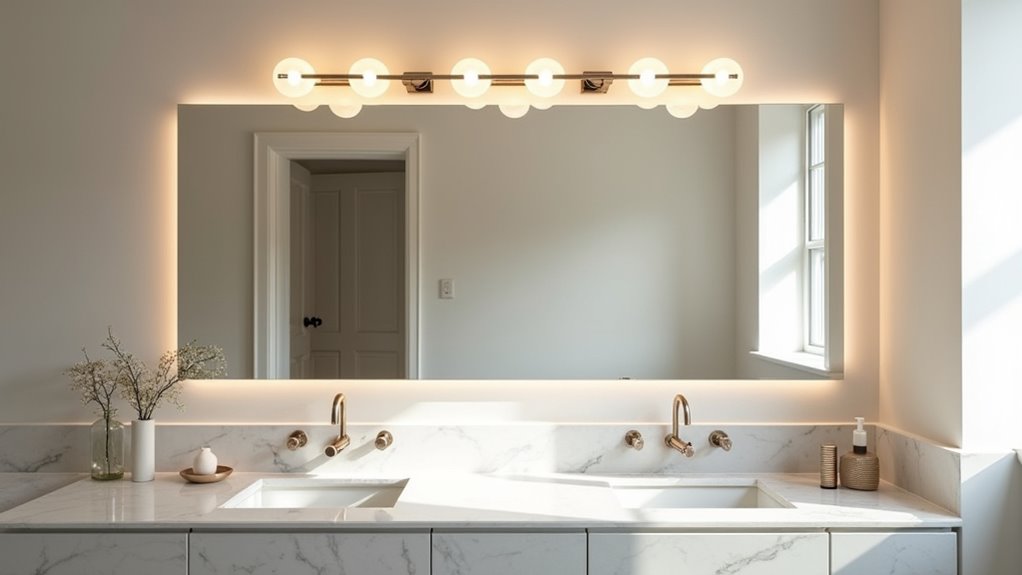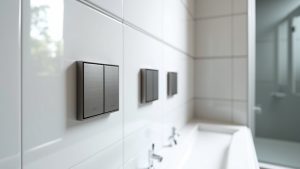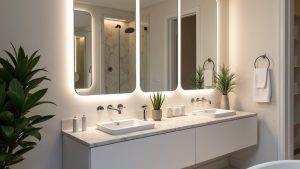Achieving perfect bathroom vanity light placement involves several key principles. Start by determining the ideal height, typically 75-80 inches from the floor. Select the appropriate fixture size, ensuring it is 75-80% of the vanity width. Position lights above the mirror for consistent illumination and consider using LED bulbs for energy efficiency. Avoid common mistakes like poor fixture placement and glare. Incorporate dimmer switches for ambiance and be mindful of IP ratings for moisture protection. Discover further insights on enhancing your space.
Key Takeaways
- Mount vanity lights 75-80 inches high, positioning them 3-10 inches above the mirror’s edge for optimal illumination.
- For side-mounted sconces, place them at eye level (60-66 inches) and 36-40 inches apart.
- Choose fixtures that are 75-80% of the vanity width and 2-4 inches narrower than the mirror for a balanced look.
- Use LED bulbs with warmer temperatures (2700K-3000K) for a better ambiance and effective makeup application.
- Incorporate dimmers for adjustable lighting, enhancing the bathroom’s mood while supporting layered lighting to reduce shadows and glare.
Determining the Ideal Height for Your Vanity Lights

When considering the ideal height for vanity lights, it is crucial to analyze both aesthetic appeal and function, as improper placement can lead to awkward shadows and an uninviting atmosphere. Standard guidelines recommend mounting lights above mirrors 75-80 inches from the floor, ideally 3-10 inches above the mirror’s edge. Sconces should be positioned at eye level, typically between 60-70 inches. These measurements serve as starting points, yet user height adjustments can further refine placement. A stylish light bar approximately 75% of the mirror width is recommended to achieve optimal balance in layered lighting solutions. Modern options, such as nature-inspired LED fixtures, utilize eco-friendly materials to enhance ambiance and blend seamlessly with contemporary interiors. However, it is essential to remember that standard measurements serve as guidelines rather than hard rules, allowing for flexibility based on personal needs. Additionally, consider the height of the vanity when determining placement, as standard vanity height typically ranges from 32 to 36 inches. For taller individuals, raising sconces height may optimize light distribution and minimize glare, while shorter users may require adjustments to avoid uneven illumination. Ultimately, thoughtful consideration of user needs alongside standard guidelines ensures an enjoyable and functional bathroom environment.
Selecting the Right Size for Your Light Fixtures

Selecting the right size for light fixtures is essential to achieving both functionality and aesthetic balance in a bathroom design. Fixture width should generally be 75-80% of the vanity width, ensuring harmony with other elements. When choosing fixtures, they should ideally be 3/4 the mirror size or slightly shorter than the vanity itself. For a balanced appearance, light fixtures above a mirror should be 2-4 inches narrower than the mirror, preventing any extension beyond its edges. For a 30-inch mirror, a fixture width of 22-28 inches is optimal. In smaller spaces, a two-light fixture may suffice, while larger vanities may require multiple fixtures for even illumination, ensuring the overall scale complements the bathroom’s proportions. Consider features like adjustable brightness levels to enhance the bathroom ambiance and functionality, as seen in some modern light fixtures. Incorporating energy-efficient LED technology in fixtures promotes sustainability, reducing electricity consumption and contributing to long term cost savings.
Positioning Lights for Optimal Illumination

Effective illumination in a bathroom hinges not only on the selection of fixtures but also on their precise positioning, as optimal light placement significantly enhances functionality and aesthetic appeal. Proper fixture positioning, especially for side-mounted lights, should be approximately 60 to 66 inches from the floor. Maintaining a distance of 36 to 40 inches between sconces ensures even distribution. Task-specific lighting, such as recessed lights, should directly illuminate work areas. Analyzing potential placement pitfalls, such as avoiding single-sided fixtures, helps refine light direction and quality.
| Light Type | Recommended Placement |
|---|---|
| Side-Mounted Sconces | 60-66 inches from the floor |
| Above Mirror | 75-80 inches above floor |
| Light Spacing | 36-40 inches apart (sconces) |
| Recessed Lighting | 12-18 inches apart |
| Task Lighting | Directed towards the face |
Choosing the Best Types of Vanity Lighting

Vanity lighting serves as a crucial element in bathroom design, influencing both functionality and aesthetics. Selecting appropriate lighting involves considering various types, including sconce styles, which provide balanced illumination and can enhance the bathroom’s decor through their elegant designs.
Bar designs offer consistent, broad lighting and can be mounted above mirrors, effectively diffusing light for optimal facial clarity. For more dramatic flair, pendant options introduce a decorative focal point, especially over double vanities when hung in pairs.
Additionally, mirror integration with built-in lighting offers a modern, space-saving solution that provides even illumination ideal for grooming tasks. Each type plays a unique role in establishing a well-lit and visually appealing bathroom environment.
Considering Bulb Characteristics for Your Bathroom

In the pursuit of optimal bathroom lighting, the advantages of LED bulbs emerge as a key consideration due to their energy efficiency and longevity.
Additionally, selecting the appropriate color temperature is critical; warmer hues create a flattering atmosphere, while cooler tones enhance task clarity for applications like makeup.
Together, these bulb characteristics not only elevate functionality but also influence the overall ambiance of the bathroom space.
LED Bulb Advantages
A significant advantage of using LED bulbs in bathroom settings lies in their remarkable energy efficiency and extended lifespan. Consuming 80-90% less energy than traditional incandescent bulbs, LEDs significantly reduce electricity bills and maintenance costs while providing bright, quality illumination. Their durability features, including resistance to moisture and shock, and a lifespan of 25,000 to 50,000 hours, make them ideal for bathroom environments. Additionally, safety benefits arise from their lower heat emission, minimizing risks in enclosed spaces. Their positive environmental impact stems from reduced energy consumption and less waste over time.
| Feature | Benefits |
|---|---|
| Energy Efficiency | Reduces bills by 75% |
| Extended Lifespan | Lasts up to 50,000 hours |
| Durability Features | Resistant to moisture and shock |
| Safety Benefits | Emits less heat, cooler touch |
Choosing Color Temperature
Illumination plays a critical role in shaping the functionality and ambiance of a bathroom, making the choice of color temperature a significant consideration when selecting lighting options.
Color temperature, measured in Kelvin (K), directly impacts how a space feels and functions. Selecting the appropriate range is essential for various tasks such as grooming and relaxation.
- Warmer temperatures (2700K-3000K) create a cozy atmosphere.
- Neutral whites (3500K-4100K) balance functionality with comfort.
- Cooler tones (4000K-5000K) enhance clarity, ideal for makeup application.
Avoiding Common Bathroom Lighting Mistakes

While many homeowners strive for an aesthetically pleasing bathroom environment, avoiding common lighting mistakes is crucial for both functionality and safety.
A single overhead light often leads to insufficient illumination, creating shadows that complicate daily tasks, such as shaving or makeup application. Additionally, neglecting task lighting near mirrors hinders visibility and can frustrate users.
Color temperature choices also play a pivotal role; selecting incorrect hues can distort skin tones and adversely affect bathroom mood.
Furthermore, poor fixture placement results in harsh shadows or glare, while ignoring layered lighting leaves the space feeling flat.
Enhancing Your Bathroom With Dimmer Switches and IP Ratings

Transforming a bathroom into a multifunctional sanctuary often involves the strategic implementation of dimmer switches and an understanding of IP ratings.
The benefits of dimmers include enhanced ambiance, energy efficiency, and improved comfort, allowing for tailored lighting as needed. Proper installation ensures safety, adhering to regulations due to the bathroom’s unique environment.
Dimmers enhance ambiance and energy efficiency, providing customizable lighting that ensures comfort and safety in your bathroom sanctuary.
- Dimmer switches help create a spa-like atmosphere.
- Selecting the right IP rating protects electrical fixtures from moisture.
- Compatibility between dimmers and bulbs prevents flickering and prolongs bulb life.




